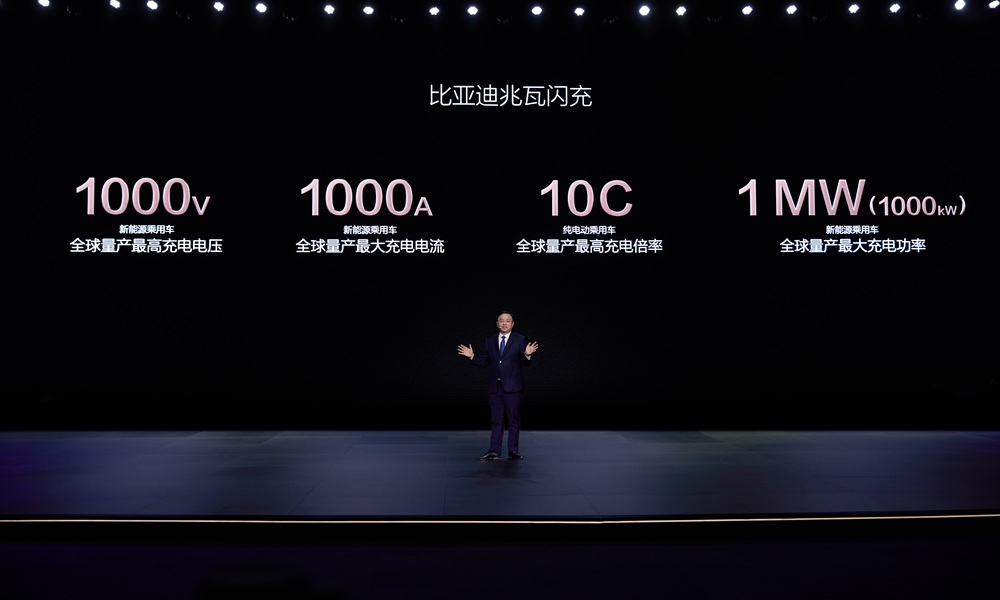BYD set a new benchmark in electric vehicle (EV) technology when it unveiled its revolutionary Super e-Platform, introducing record-breaking Megawatt Flash Charging technology that delivers charging speeds comparable to refueling internal combustion engine (ICE) vehicles.
Announced on March 17, 2025, the platform introduces numerous first-to-market advancements that position BYD significantly ahead of global competitors. The technology promises to revolutionise the EV landscape, says analyst S&P Global.
The Super e-Platform’s standout feature is its unprecedented charging capability. With a charging power of 1 megawatt (1000 kW), the new platform offers a peak charging speed of 2 kilometers per second, allowing vehicles such as the BYD Han L and Tang L to achieve up to 400 kilometers of range with just a five-minute charge. This rapid charging addresses the critical issue of “charging anxiety,” a barrier often cited as limiting EV adoption. BYD Chairman and President Wang Chuanfu emphasized during the launch event that “the ultimate solution is to make charging as quick as refueling a gasoline car.”
The technological breakthroughs enabling this ultra-fast charging include the platform’s full-domain 1000V high-voltage architecture—the world’s first for mass-produced passenger vehicles. Additionally, BYD has launched its “Flash Charging Battery,” which integrates ultra-fast ion channels from positive to negative electrodes, effectively reducing battery internal resistance by 50%. The battery supports an unmatched charging current of 1000A and a charging rate of 10C — both world records.
Further innovation includes the industry’s first mass-produced 30,000 RPM electric motor, significantly enhancing vehicle performance by improving speed, reducing motor weight, and increasing power density. Complementing this is BYD’s next-generation automotive-grade silicon carbide (SiC) power chips, rated up to 1500V, ensuring stable, efficient operations in ultra-high-power charging scenarios.
To support this advanced technology, BYD has also developed the world’s first all-liquid-cooled Megawatt Flash Charging terminal system, capable of outputs up to 1360kW. BYD plans to deploy over 4,000 Megawatt Flash Charging stations across mainland China, featuring innovative “dual-gun charging” that converts existing stations into flash-charging-capable units. BYD’s proprietary “intelligent voltage boost” technology ensures full compatibility with existing public charging infrastructure.
According to analysis by S&P Global, BYD’s new platform is a gamechanger. Mainland China, already the largest EV market globally and home to leading EV manufacturer BYD, will significantly benefit from the technology. With pricing for the new Han L and Tang L models ranging from approximately $37,330 to $49,000, BYD’s offerings are competitively positioned, potentially reshaping market dynamics internationally.
With a robust strategy of vertical integration, including in-house development of critical components such as SiC semiconductors, BYD is poised to lead the EV industry into its next technological era. This advancement marks a significant milestone in EV evolution, positioning BYD not only as a dominant player in China but also as a formidable competitor on the global stage.
There are many firsts in BYD’s Super e-Platform. It will be the first mass-market EV platform in the world to feature a 1,000-V all-domain high-voltage system architecture. This architecture improves energy efficiency by minimizing energy loss and enabling more effective power distribution across the vehicle’s systems.
Currently, most EVs operate on 400-V systems, with only a few models utilizing the 800-V architecture, primarily in the high-end segment.
The architecture allows peak charging at 1,000 kW, which will add 400 km (249 miles) in just 5 minutes. This is made possible through the integration of several advanced technologies such as a fast-charging battery system and advanced power electronics.
To manage the exceptionally high charging speeds, BYD has introduced an innovative dual-inlet DC charging port design. This setup suggests that each port will deliver 500 amps, combining to achieve the full 1,000-kW charging capacity.
The key part of the Super e-Platform is BYD’s redesigned Blade batteries with a 10C charging multiplier, the highest in the industry. This means the battery can be charged up to 10 times its capacity per hour, enabling rapid replenishment without overheating. BYD has also developed the all liquid-cooled megawatt flash charging terminal system that helps manage the high temperatures generated during rapid charging, ensuring better safety and longer life. Together, these developments demonstrate considerable progress has been made by BYD in the field of battery thermal management and battery management systems.
With its previous generations of lithium iron phosphate (LFP) Blade batteries, BYD has already proven itself to be a pioneer in fast-charging battery technology. The current iteration of the battery positions BYD well ahead of its competitors, including Tesla, which has been regarded as the benchmark for several of these attributes.
Besides, the Super e-Platform includes the fastest mass-produced electric-motor globally, capable of reaching 30,511 revolutions per minute (rpm) with a peak power output of 580 kW.
According to S&P Global, the Super e-Platform’s next-generation silicon carbide (SiC) power chips, rated up to 1,500 V, are another record in the EV domain: “Developed in-house by BYD, these chips improve reliability and performance for the ultrafast-charging systems, ensuring stable and efficient operations.
Many original equipment manufacturers are moving toward integrating hardware and software, the analyst notes.
“So, the focus should be on key semiconductors such as SiC, system-on-chips (SoCs), microcontroller units (MCUs), and power management integrated circuits (PMIC), which are essential for advancing electrification and software-defined vehicles (SDVs). Notably, BYD is the first OEM to develop and apply SiC semiconductors in its vehicles, achieving higher voltage classes compared to other OEMs.
“As BYD works toward establishing itself as a major player in other regions, especially Europe, it may not be long before this technology is introduced in those markets. Given the price point of the Han L and the Tang L, they will be a lot more accessible than other ultrafast-charging 800-V models such as the Tesla Cybertruck, Audi e-tron GT and Porsche Taycan. Thus, BYD’s tours de force are real gamechangers, standing in comparison with the wide ramifications felt through the AI industry by the DeepSeek reveal earlier in 2025.”



